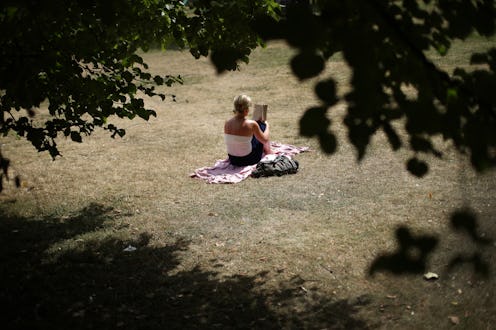Books
These Novels Should've Had Female Main Characters
Love stories are good stories. Some of the most famous and best books by women — and about women — focus on love, marriage, and motherhood. So when The Atlantic said that it’s frustratingly rare to find a novel about women that’s not about love, I went on the defensive. Love is a strong emotion, a basic human experience. These stories are important.
But, loath as I am to admit it, they have a point. Certain kinds of stories don’t get told about women — and it becomes especially apparent when you start reimagining some of our culture’s most beloved books with a female main character. There are very few literary novels about women who are soldiers or mad scientists, or of ladies fighting for survival and embarking on adventures. We could use some more thrill-seeking role models. Let's add in some anti-heroines, as well — hardened criminals and corrupt “everywomen.”
We can find these books in genre fiction and children’s literature. Why not literary fiction, too? While we’re waiting, let’s take a look at a few great works that would be improved with a little gender-switching:
Frankenstein
What if Dr. Frankenstein were a woman, a lonely scientist with a passion for reanimating corpses? She might have had the foresight to make her creation a petite and demure lady and nurtured her into a fulfilling existence.
Crime and Punishment
You know what women don’t do enough in fiction? Murder! These novels are a dime a dozen with a male protagonist: broody, intellectual young man rationalizes terrible actions, goes through moral crisis, etc., etc. Rarely does a woman get this same freedom in a novel. Women can be axe-murderers, too!
The Adventures of Huckleberry Finn
I want to see a young teenage girl named Huckleberry Finn fake her own death, hop on a raft, and float down the Mississippi in 19th century America. She could fight off thieves and befriend grifters. Or better yet, the protagonist could be Huckleberry’s friend, an escaped slave in search of freedom. Let’s call her Jem.
The Strange Case of Dr. Jeckyll and Mr. Hyde
It would be pretty groundbreaking to read about a female doctor in the Victorian era. Maybe she could start drinking a mysterious serum, transforming her into the wicked Miss Hyde. In this old-fashioned battle between good and evil, Miss Hyde would wreak havoc on London, stomping around her laboratory and beating up men with canes.
For Whom the Bell Tolls
Ernest Hemingway thought Willa Cather couldn’t write about soldiers, accusing her of ripping off the battle scenes in One of Ours from the film Birth of a Nation. Harsh words from someone who couldn’t write convincing women characters to save his life. For Whom the Bells Tolls would have been better if Robert Jordan had somehow been a woman (let’s call her Roberta), an American guerrilla soldier during the Spanish Civil War. Or, better yet, if Maria, with her edgy shorn locks, had been the main character instead.
The Fountainhead
This doorstopper of a novel had a huge impact on me... as an impressionable 15-year-old. It bugged me though — even then! — that Ayn Rand’s individualist philosophy didn’t seem to work out quite as well for women as it did for men. Maybe Dominique should have been the main character, a visionary architect, rather than “the woman for a man like Howard Roark,” as Rand described her. Then we could forget about that weird rape scene, too.
Catcher in the Rye
Practically every coming-of-age book that’s come out since 1951 gets touted as the next Catcher in the Rye. What if Holden Caulfield were an angst-ridden, alienated teen girl? Would millions of readers latch on to her? Or would they give the book a girly cover and relegate it to the YA bookshelves?
Lord of the Flies
This story of schoolboys gone wild has inspired many an 8th grader to pen the essay, “What if girls had been stranded on the island instead of boys?” Some speculate that girls would have died of starvation, too busy crying to search for food. Others suggest that girls would have had such a great time making grass skirts and drinking coconut juice that they wouldn't have bothered tormenting poor Piggy. Clearly a new version of this book is needed to show how a ragtag group of girls would hold onto their humanity (or not) during their struggle to survive.
A Clockwork Orange
Now we have Katniss Everdeen, but in classic dystopian novels, it’s men who get the starring roles. I’d like to read a story about a gang of teenage girls in futuristic London, committing acts of ultra-violence to the soundtrack of the Lovely Ludwig Van. The revamped anti-heroine could even go by the same name as the original: Alex.
Rabbit, Run
If Rabbit Angstrom were a woman, they’d probably call her Bunny. Bunny wouldn’t run away and shack up with a prostitute to escape her unhappy marriage. Pregnant with her second child, she would kick her sad-sack husband out of the house and deal with things. With her husband out of the way, she would focus on finding an adequate support network. With any luck, someone would keep her away from the bathtub.
High Fidelity
Rob Fleming could be Robin, a female record store owner, reeling from a breakup, on a mission to track down all her ex-boyfriends. Hmm. With a woman at the center of the story, this contemporary classic sounds like a lot of other books about love and relationships. This brings me back to my original point: there is nothing wrong with a good love story, but we need more books about women scientists on death-defying adventures. And, as Nick Hornby has demonstrated, a few more books about men and their love lives wouldn’t hurt, either.
